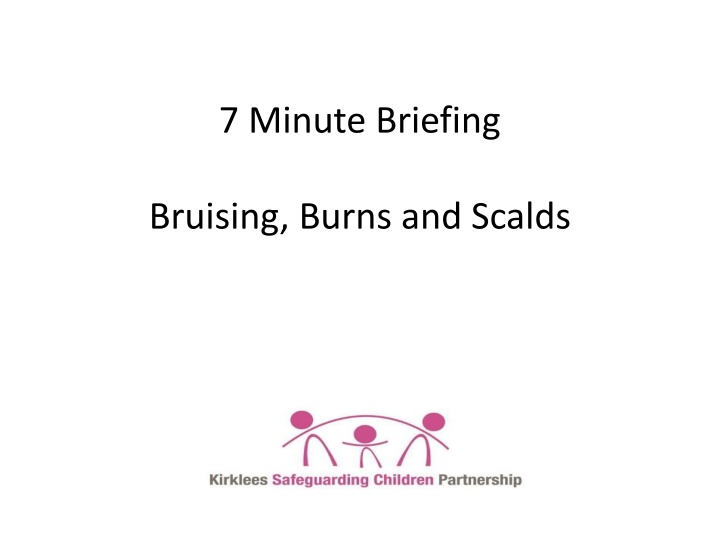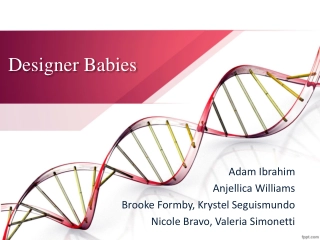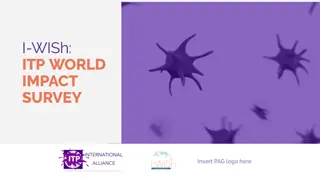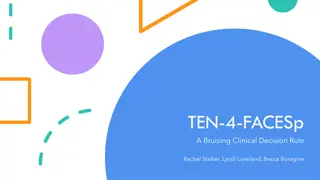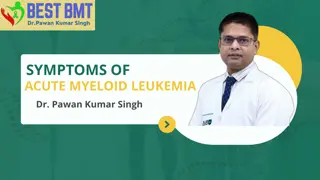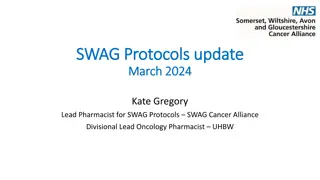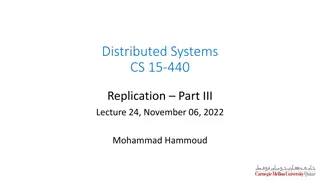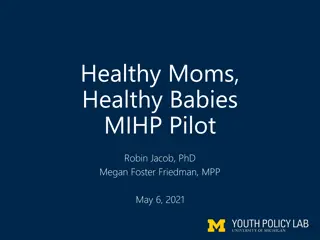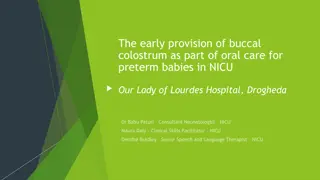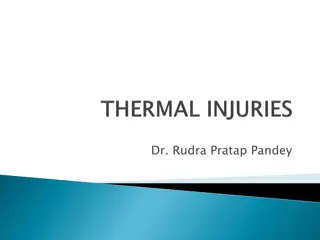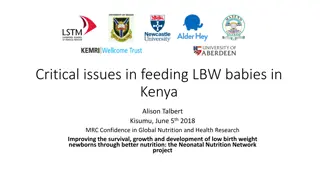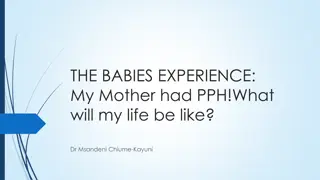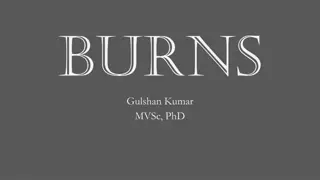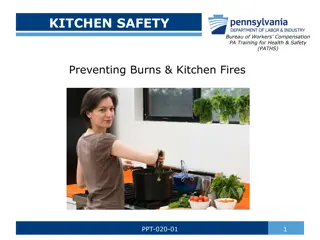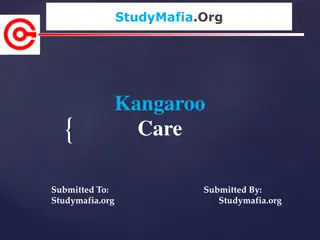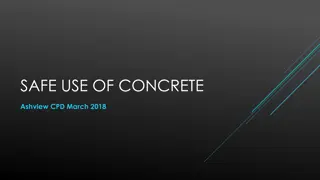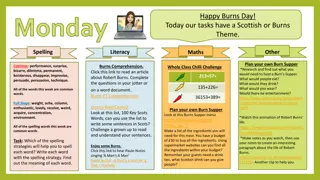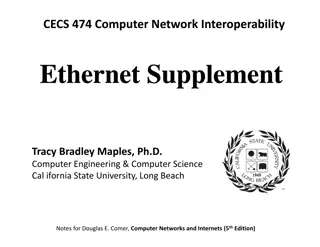Protocols for Addressing Bruising, Burns, and Scalds in Babies
Bruising is the most common accidental injury in children, especially those with increased mobility. Non-mobile babies sustaining bruising should raise suspicion of abuse and prompt thorough investigation. Professionals are required to refer all suspected injuries in non-mobile babies for assessment of harm risk, involving multi-agency collaboration. Trained health professionals can differentiate birthmarks from bruises to avoid unnecessary referrals. Parental/carer consent for referrals should be sought, but risks to the baby must be considered when deciding whether to inform them. In all cases, Children's Social Care must be alerted.
Download Presentation

Please find below an Image/Link to download the presentation.
The content on the website is provided AS IS for your information and personal use only. It may not be sold, licensed, or shared on other websites without obtaining consent from the author.If you encounter any issues during the download, it is possible that the publisher has removed the file from their server.
You are allowed to download the files provided on this website for personal or commercial use, subject to the condition that they are used lawfully. All files are the property of their respective owners.
The content on the website is provided AS IS for your information and personal use only. It may not be sold, licensed, or shared on other websites without obtaining consent from the author.
E N D
Presentation Transcript
7 Minute Briefing Bruising, Burns and Scalds
Bruising is the most common accidental injury experienced by children, and research shows that the likelihood of a baby sustaining accidental bruising increases with increased mobility. The evidence suggests that it is extremely rare for a non-mobile baby to sustain accidental bruising. Therefore all such bruising should be suspected by professionals to be an indicator of physical abuse and should be thoroughly investigated. This phrase refers to babies, who are to some degree independently mobile e.g. crawling, bottom shuffling, pulling to stand, cruising or walking independently. Please note however that some babies can roll from a very young age and this does not constitute self-mobility. Published evidence suggests that children under the age of three and particularly those under one year, are most at risk of suffering physical abuse. However, practitioners are reminded that all children are vulnerable to harm and as such practitioners should remain alert to signs of abuse, unexplained or unusual injuries; or injuries where the explanation provided is not congruent with the injury sustained.
This protocol requires that all actual or suspected bruising, burns or scalds to babies who are not yet self-mobile should be subject to multi-agency investigation in order to assess risk of harm. For this reason, any professional who identifies such an injury to a non- mobile baby is required to make a referral to the Children's Social Care, regardless of the explanation offered by parents or carers, and regardless of the professional s own opinion about how the injury may have been caused. A decision that the child has not suffered abuse must be a joint decision and must not be made by an individual or single agency.
There are a number of conditions that can mimic or present with bruises. If a trained health professional is confident that the mark is a birth mark and not a bruise this can be clearly documented in the records and a referral under this protocol is not necessary.
Informing the Parents/Carers and Obtaining Consent It would be expected that in most cases the professional will inform a parents/carer of their intention to make a referral and obtain their consent. However, in judging whether or not to inform the parent/carer that a referral is to be made, the professional who has identified the suspected injury must consider the possibility that to do so may increase the level of risk to the baby. In this instance the professional does not need to obtain consent to make a referral. If the professional concludes that informing the parent/carer may increase the level of risk to the baby, they should consult with Children's Social Care or the child s allocated Social Worker before speaking to the parent in order to obtain advice. In all cases, Children's Social Care must be advised if the parents or carers are aware of the referral.
Action to be taken by Childrens Social Care Referrals made to Children's Social Care under this protocol will always be deemed to be high priority due to the vulnerability of the child concerned. If the baby or family are not already in receipt of a service from the Children's Social Care will follow safeguarding children procedures and record the information as a high priority referral. This referral will then be transferred to the Joint Investigation Team. Following a referral being made and subsequent strategy discussion, all referrals made under this protocol will be deemed to meet the criteria for an Enquiry under S47 Children Act 1989 to determine whether the baby has suffered or is at risk of suffering significant harm. Multi-agency safeguarding procedures must be followed from the point of referral regardless of whether this is the responsibility of Children's Social Care or a field social work team.
The Paediatric Assessment The examining Paediatrician will participate in all Strategy Discussions that are initiated in line with this Protocol. All babies referred to Children's Social Care under this protocol must have a Child Protection medical assessment. The medical assessment should be carried out by a paediatrician with the appropriate training, competencies, and supervision as per Safeguarding Children and Young People: Roles and Competencies for Health Care Staff (RCPCH 2014). Once a strategy discussion has confirmed that a section 47 enquiry is required under the terms set out in this protocol, Parents/carers must not be asked to take the baby to the hospital Emergency Department or to their GP as a substitute for assessment by a hospital Paediatrician.
Wherever possible, the examination should be attended by a member of Children s Social Care staff. If the family is already known to social care then a worker who is familiar with the family should ideally attend. However in cases where this is not possible e.g. with a family who are not previously known to Children's Social Care, the worker(s) attending with the family should be familiar with the referral that has been made, the nature of the suspected injury etc The Paediatrician should arrange for additional medical investigations if the circumstances warrant this. The paediatrician will provide a verbal opinion at the time of the medical assessment, which will be followed up in writing within 72 hours, unless it has agreed that it will be sooner. If the Social Worker, upon receipt of the report, is unclear about the medical opinion, they must contact the Paediatrician to clarify this.
The key principle of this protocol is that when a non-mobile baby has sustained injuries as outlined in this document, decisions should not be made by a single agency. As a minimum, decisions should be made by a group consisting of a Social Worker, Police Officer and Paediatrician. This protocol does not seek to remove or undermine professional judgement, but rather to support it (and encourage professional challenge where appropriate) in a multi-agency environment to ensure the best outcomes for children and families. At the close of the S47 Enquiry, Children's Social Care should have made an assessment in relation to whether the baby has suffered or is at risk of suffering significant harm. This assessment should have been developed in full consultation with all relevant partner agencies.
In some cases, the outcomes of the S47 Enquiry may not be clear e.g. the findings of the paediatric assessment may be inconclusive or agencies may hold differing views about the level of risk. In such cases a strategy discussion should be convened and chaired by a Team Manager or Principal Social Worker from Children's Social Care in line with West Yorkshire Safeguarding Procedures. The process of bringing the relevant professionals together to discuss the case may contribute to better assessment and outcomes. This assessment will inform the action to be taken by children s social care and/or West Yorkshire Police.
It is expected that all referrals under this protocol will be responded to, and assessment commenced on the same day that the referral is received. If this is not possible, then arrangements should be made for assessment to commence at the start of the following day at the latest. In all cases, a Strategy Discussion and Paediatric Assessment should have been undertaken within 24 hours of receipt of the referral.
KSCP Website - https://www.kirkleessafeguardingchildren.co.uk/ Twitter - @KirkleesLSCP Telephone 01484 225161
